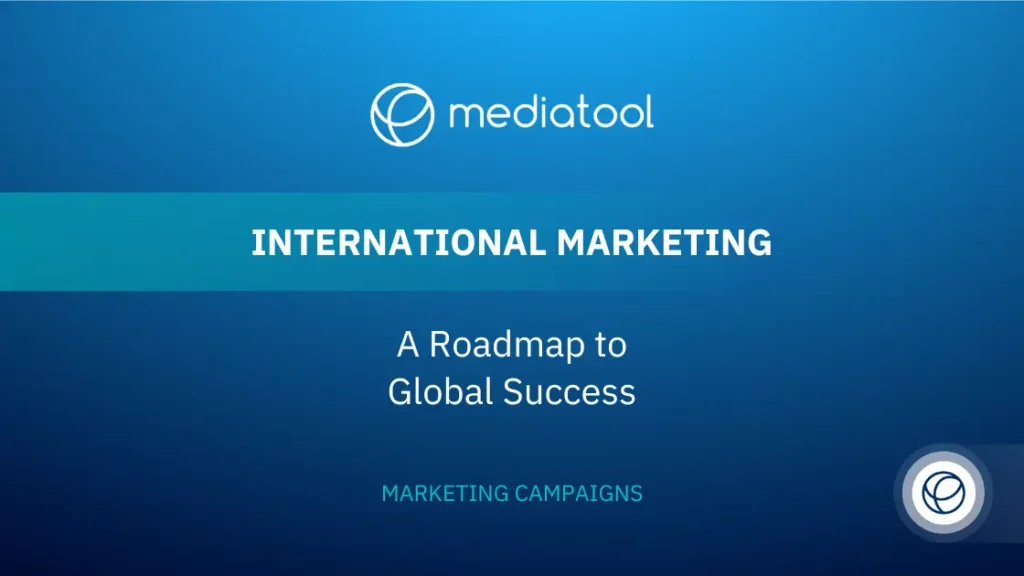Navigating the challenges of international marketing can seem like a huge challenge.
Every country has its own set of cultural, language, and regulatory hurdles that can complicate your efforts to expand globally.
However, having a strong international marketing strategy is the secret to overcoming these challenges.
A good strategy allows businesses to connect with their international audience effectively, ensuring their brand is globally appealing and locally respectful.
This article is here to guide you through creating a successful international marketing strategy, providing you with practical tips and insights to help your business grow worldwide.
What is International Marketing
International marketing extends beyond borders. It’s how businesses promote and sell products or services across the globe. Unlike domestic marketing, it requires a keen understanding of multiple cultures, legal systems, and market dynamics.
At its core, international marketing aims to connect with a global audience, ensuring that marketing efforts resonate with people from around the world.
What are the Benefits of International Marketing

Expanding Customer Base and Diversifying Revenue
Delving into international markets opens up a plethora of opportunities for businesses. It not only broadens the target audience but also diversifies revenue streams.
Tapping into foreign markets means accessing new customer segments eager for your offerings, providing a significant boost to your business’s reach and financial health.
Achieving Economies of Scale
Venturing into new markets can lead to economies of scale. As businesses expand and production volumes increase, the cost per unit often decreases. This reduction in overall costs is a strategic move to enhance competitiveness and profitability on a global scale.
Fostering Innovation and Learning
International exposure is a catalyst for learning and innovation. By entering diverse markets, companies encounter unique challenges and customer preferences, driving them to innovate. This constant evolution helps businesses stay ahead of domestic and international competitors, ensuring they remain relevant in a fast-paced global industry.
Boosting Global Brand Recognition
One of the paramount benefits of international marketing is the significant boost it gives to brand recognition across different countries. Establishing a presence in foreign markets elevates a local brand to international status, enhancing its visibility and appeal to global customers and target audiences.
This global recognition is essential for any business aiming to become a household name worldwide.
Building on this view, it’s interesting to note that around 64% of marketers globally expect to spend more on advertising this year. Even more notable, about 13% of them plan to increase their budgets by more than 50%. This kind of spending shows just how much value is placed on using international marketing to make a brand more recognizable around the world. It highlights the strategic investments companies are making to improve how visible and attractive their brand is to people everywhere.
The Importance of International Marketing Strategies
Tailoring Marketing to Cultural Nuances
The essence of crafting international marketing strategies lies in their ability to resonate with the local market while maintaining the brand’s core values. Successful global marketing strategies go beyond mere translation; they require a deep understanding of cultural differences, language nuances, and local tastes.
This tailored approach ensures that marketing campaigns are not just seen but also felt, fostering a connection with international consumers.
Ensuring Consistency While Adapting to Local Preferences
A well-thought-out international marketing strategy balances consistent branding with adaptations that reflect local preferences. This balance is crucial for businesses to communicate their brand’s values effectively across various markets.
By doing so, companies can build trust and loyalty among international customers, ensuring that their brand is recognized and revered globally.
Driving Global Growth
Ultimately, the importance of international marketing strategies cannot be overstated. They are the backbone of a business’s global expansion efforts, providing a roadmap for successfully entering new markets and securing a competitive advantage.
Through strategic planning and execution, businesses can enhance their market share, appeal to target customers in different cultures, and achieve sustainable growth on a global scale.
Steps to Creating an International Marketing Strategy

1. Conduct Thorough Market Research
Kicking off with thorough market research is non-negotiable. This foundational step is your key to unlocking international marketing success. It’s all about diving deep into different markets, understanding what makes local consumers tick, and eyeing the competition closely. Market research isn’t just a box to check; it’s your treasure map.
It guides you in customizing your products and marketing campaigns to resonate with local markets. Remember, every insight gained is a step closer to making your brand a household name on a global scale.
2. Understand Cultural Differences
Never underestimate cultural differences; they’re the heartbeat of successful global marketing strategies. Gaining a deep understanding of local cultures, languages, and etiquettes isn’t optional—it’s essential.
This knowledge shapes your communication strategies, ensuring your marketing messages aren’t just heard but felt. It’s about striking the right chord with international audiences, making every word count, and showing respect through understanding.
After all, the goal is to make your brand globally relatable, one cultural insight at a time.
Surprisingly, fewer than 40% of marketers utilize consumer research to inform their decision-making processes. This statistic underscores the untapped potential of leveraging deep cultural insights to refine marketing strategies. By integrating consumer research, marketers can significantly enhance their understanding of local preferences and nuances, thereby elevating their global marketing efforts.
3. Develop a Global Marketing Mix
Crafting a global marketing mix that’s as flexible as it is strategic is your next big move. It’s about finding that sweet spot between adapting to local tastes and keeping your brand’s values shining bright.
Whether it’s tweaking your product, adjusting prices, choosing the right distribution channels, or nailing your promotional tactics, every decision counts. This balanced approach not only appeals to target markets across multiple countries but also cements your brand’s identity worldwide.
Reinforcing this strategy, campaigns that leverage three or more channels can see a purchase rate that is 287% higher compared to those that use only one channel. This statistic highlights the effectiveness of a multi-channel approach in engaging customers and driving sales globally. By diversifying your marketing mix across various channels, you can significantly enhance your brand’s reach and impact, catering to the preferences of a global audience.
4. Optimize for Local Search Engines and Social Media
In today’s digital age, an online presence is your golden ticket to international brand recognition. Optimizing your content for local search engines and making waves on social media can catapult your brand into global markets.
It’s more than just posting; it’s about engaging. Collaborate with local influencers, spark conversations, and create content that speaks directly to local consumers. This digital dance is what turns viewers into loyal followers, and followers into customers, on a global scale.
Reinforcing this, a striking 89% of consumers indicate they are likely to buy from brands they follow on social media, and 84% say they would choose these brands over their competitors. This highlights the critical role of social media in not only building a global brand presence but also in driving consumer preference and loyalty.
5. Establish Local Partnerships
Navigating a foreign market is no solo journey. Forming partnerships with established companies or diving into joint ventures can give you an unparalleled competitive edge. These alliances aren’t just about sharing resources; they’re about sharing wisdom.
Tapping into local networks, understanding market nuances, and easing your way into new markets become significantly smoother with the right partners by your side. Think of it as a bridge-building exercise, where collaboration paves the way for mutual success.
88% of marketers consider partner marketing essential, recognizing it provides significant value—with 51% seeing it as highly valuable and 37% acknowledging it offers some value. This perspective underscores the strategic importance of partnerships in expanding your brand’s global footprint, highlighting how collaboration with local partners is key to unlocking market potential and navigating the complexities of new landscapes effectively.
6. Monitor, Adapt, and Innovate
The global market waits for no one. It’s ever-changing, always evolving. This is why keeping your finger on the pulse—monitoring trends, gathering customer feedback, and eyeing what the competition is up to—is crucial.
This vigilance enables your brand to stay agile, adapt strategies, and innovate product offerings. Whether you’re expanding into new markets or strengthening your hold in existing ones, staying ahead of the curve is what keeps your brand relevant and resilient in the global marketplace.
By weaving these steps into your international marketing efforts, you’re not just launching a campaign; you’re embarking on a journey. A journey that requires patience, insight, and a willingness to adapt, but one that promises unparalleled growth and the chance to turn your brand into a beloved name, far and wide. Remember, the world is your market; navigate it wisely.
International Marketing Strategy Examples
Exploring unique and compelling examples of international marketing strategies offers valuable insights into the diverse approaches companies take to navigate global markets successfully.
Here are some innovative examples from brands that have masterfully executed their global marketing strategies, incorporating essential terms and concepts:
Spotify: Mastering Global Standardization and Localization
Spotify’s global marketing strategy showcases a perfect blend of global standardization and localization, crucial for engaging an international audience. By offering a vast library of international music alongside playlists curated to cater to the local tastes of each target market, Spotify has become a brand worldwide.
Their approach emphasizes the importance of understanding language differences and cultural nuances, providing valuable insights into user preferences. This strategy not only respects intellectual property laws across different countries, including the Middle East, but also encourages users to explore new genres, making Spotify a leading figure in the international business of music streaming.
Airbnb: Navigating International Business and Local Cultures
Airbnb’s successful global marketing strategy hinges on its ability to provide authentic travel experiences while respecting domestic markets’ regulations and customs. Their marketing campaign transcends mere accommodation sharing, encouraging hosts to offer unique local experiences, thus appealing to a broad international audience seeking immersion in new cultures.
Airbnb’s efforts to collaborate with local authorities and communities demonstrate a sophisticated understanding of business abroad, ensuring their platform offers both universal appeal and local sensibility.
Red Bull: Global Branding through Content Marketing
Red Bull exemplifies a successful global marketing strategy by leveraging content marketing to build a brand worldwide. Their international marketing campaign, focused on extreme sports and adventure, resonates across foreign markets, transcending language differences through universally appealing visuals and narratives.
By generating valuable insights into their target market’s preferences, Red Bull has established itself as a global company synonymous with energy and excitement, fostering a strong connection with their international audience.
Uniqlo: Strategic Adaptation in Global Expansion
Uniqlo’s approach to international business showcases how global companies can achieve brand recognition and expand into new markets by adapting to local preferences. Their global marketing strategy balances universal brand values with local tastes, adjusting product lines to meet each domestic market’s climate and fashion sensibilities.
This strategic adaptation and collaboration with local designers demonstrate Uniqlo’s commitment to respecting cultural and language differences while protecting intellectual property and encouraging users to embrace their innovative yet accessible fashion.
These examples underscore the complexity and importance of crafting a successful global marketing strategy that respects cultural nuances, navigates legal and regulatory landscapes, and engages with international consumers on a meaningful level.
By prioritizing customer-centric approaches and local relevance, companies can enter new markets and build lasting relationships with their international audience, driving global growth and establishing a lasting brand worldwide.
Conclusion
International marketing is more than just selling abroad; it’s about creating meaningful connections with international audiences. A well-crafted international marketing strategy considers cultural nuances, employs thorough research, and adapts to local tastes while maintaining a cohesive brand message.
By embracing these practices, businesses can achieve international marketing success, expanding their global reach and establishing themselves as successful global brands. The journey to international markets is challenging but immensely rewarding, promising growth opportunities on a global scale.
Looking for ways to build and optimize global campaigns? Take a tour of Mediatool to see how you can manage all your global campaigns from the same place.





